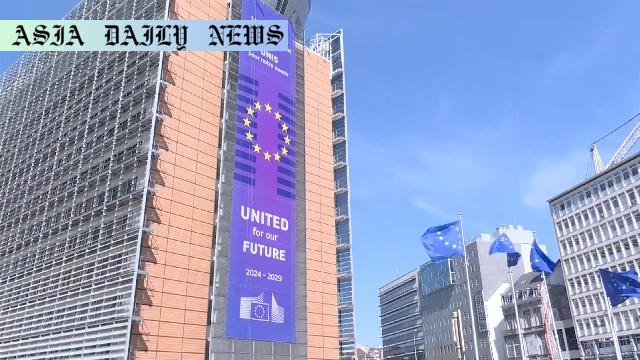Russian oil sanctions, EU lowers the seaborne crude oil price cap to counter Moscow’s ongoing invasion of Ukraine.
EU reduces Russian oil price cap from $60 to $47.6 per barrel.
Sanction aims to target Moscow’s energy revenue and economy.
Additional sanctions imposed on 105 Russian shadow fleet vessels.
The revised cap aligns with market variations and is reviewed semi-annually.

EU Implements Stricter Sanctions on Russian Oil
The European Union (EU) has stepped up its sanctions on Russia by reducing the price cap on Russian oil transported by sea. Effective immediately, the cap has been adjusted from $60 to $47.6 per barrel, a significant move aimed at crippling one of Moscow’s major economic lifelines. The decision comes as part of the bloc’s broader effort to deal economic blows to Russia amidst its continued invasion of Ukraine. This adjustment signifies an intensified strategy to pressure the Kremlin into ending the conflict.
Background on the Sanctions
In December 2022, the EU, in collaboration with the Group of Seven (G7) nations and Australia, initially implemented a $60 per barrel price cap on Russian oil. The cap was established as a means to curtail Moscow’s oil revenue, which is extensively used to fund its military operations. By lowering the cap further, the EU aims to keep the Russian economy under strain and starve cash flow from crude oil exports, a major source of revenue for the country. This step also signals the bloc’s commitment to maintaining a united front against Russia’s aggression, despite challenges in achieving an international consensus.
Market-Based Adjustments and Reviews
The newly established cap is designed to fluctuate based on market conditions, ensuring it remains 15 percent below the average market price. This dynamic pricing model allows the EU to tighten or loosen restrictions in line with shifts in the global energy market. Furthermore, the cap is set to be reviewed every six months, adding an additional layer of scrutiny to the sanction mechanisms. Analysts see this as a proactive approach to disrupt Russia’s ability to adapt and circumvent international restrictions.
Targeting Russia’s Shadow Fleet
In addition to the price cap, the EU announced sanctions on 105 vessels within Russia’s so-called shadow fleet. These ships allegedly operate outside international norms by transporting Russian crude while sidestepping restrictions. The move to blacklist such vessels indicates an intensified focus on enforcement, as the EU looks to close loopholes exploited by the Russian regime. By targeting these maritime operations, the bloc aims to further restrict Moscow’s avenues for oil exports.
Global Cohesion and Challenges
While the EU and Britain have coordinated these new measures, questions remain about whether other G7 nations, particularly the United States, will adopt similar policies. Maintaining global cohesion has been critical in making earlier sanctions effective, and any fragmentation could lessen the impact of these new measures. Still, the EU remains optimistic that these updated measures will compel Moscow to reconsider its current trajectory in the Ukraine conflict.
Conclusion
The EU’s decision to lower the price cap on Russian seaborne oil highlights the bloc’s resolve to tighten economic sanctions against Moscow. By targeting both pricing and enforcement loopholes, the sanctions aim to weaken Russia’s oil revenues and create further economic strain. Whether these measures are enough to push Moscow toward peace talks remains to be seen, but the EU’s actions send a clear signal of continued determination and unity in confronting Russian aggression head-on.
Commentary
The Importance of Stronger Sanctions
The European Union’s decision to further reduce the price cap on Russian oil reflects a necessary and resolute response to Moscow’s defiance. As Russia continues its aggression in Ukraine, this move underscores the EU’s strategy to exert economic pressure on the Kremlin. By targeting oil revenues, which serve as a primary funding source for the war, the EU ensures that the sanctions hit at the core of Russian financial stability. This targeted approach not only seeks to weaken Russia’s economy but also reaffirms the international community’s resolve to support Ukraine.
Broader Implications of the Sanction Strategy
While the intention of these sanctions is clear, the broader implications of such measures cannot be ignored. The introduction of a fluctuating cap that aligns 15 percent below market prices adds adaptability to the policy, a necessary tool in today’s volatile global oil market. However, questions arise about compliance and enforcement, particularly in tracking Russia’s shadow fleet. The success of these sanctions depends on international cooperation and the diligent monitoring of shipping and trading activities, which pose logistical and political challenges.
The Need for Global Unity
The EU’s anticipation of similar measures from other G7 members highlights the importance of a unified global stance against Russia’s actions. However, it is uncertain whether other influential players, like the United States and some Asian countries, will follow suit. Divergences in policy could create loopholes for Moscow to exploit, undermining the effectiveness of these new measures. Nonetheless, the EU’s proactive steps set an important precedent and demonstrate their commitment to raising the stakes in a bid to curb the ongoing aggression.
Looking Ahead
The EU’s latest sanctions serve as a reminder of the interconnectedness of economies and the international community’s responsibility to act collectively against violations of international law. While these actions alone may not immediately bring peace, they send a strong signal of accountability, demonstrating that aggression will not go unanswered. As future reviews of the price cap take place, the key to long-term success lies in cooperation, rigorous enforcement, and the continued resolve to support Ukraine in the face of adversity.


